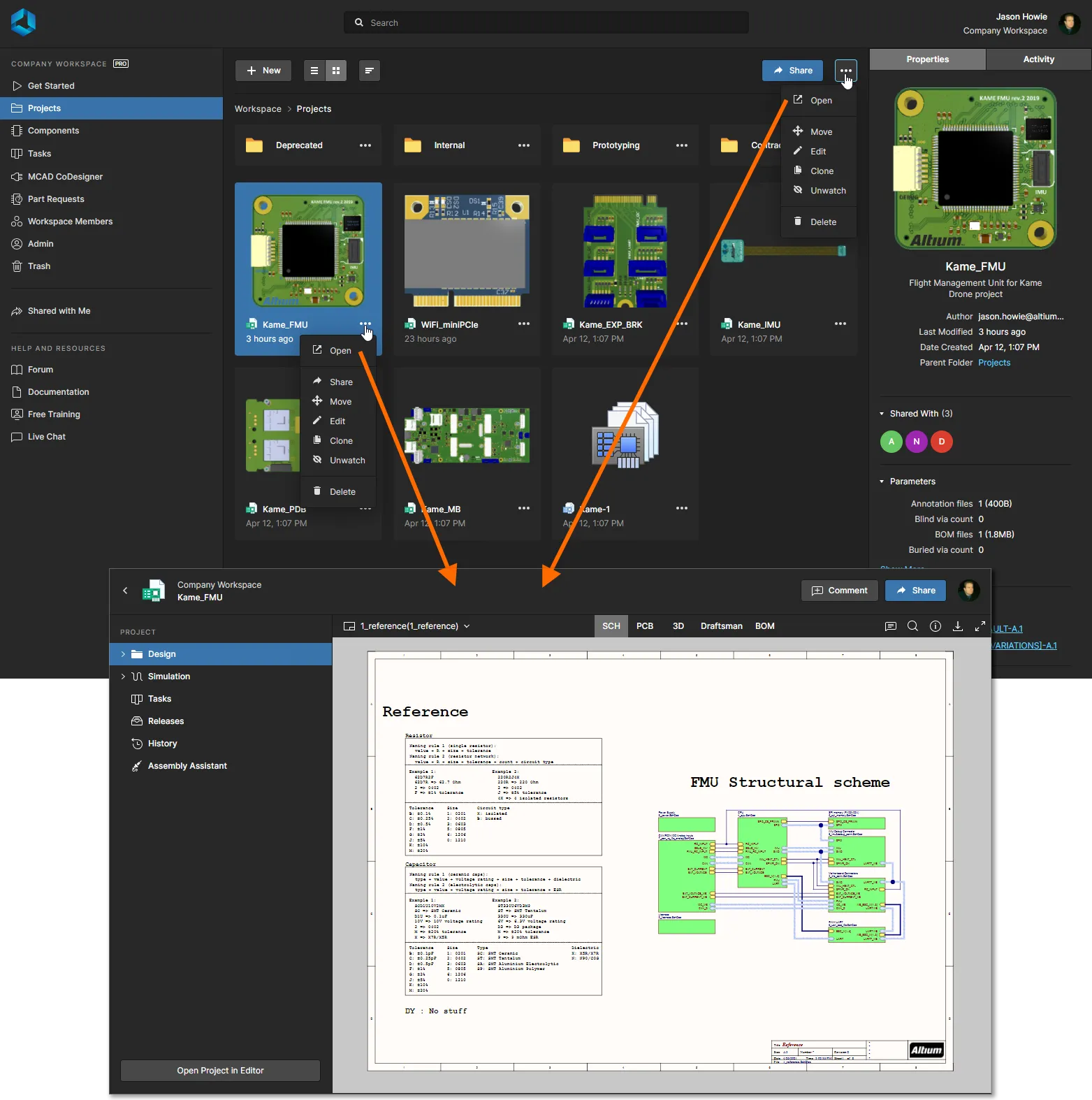父页面: 工作区项目
工作区提供了一个高级的、面向制造的CAD中心项目视图。这个管理界面提供了设计、任务和历史视图选项,以及更多功能:
请注意,您还可以通过填充工作区项目历史视图的提交或发布事件来查看设计的以往版本。要这样做,请从提交事件磁贴的菜单命令中选择
查看选项,或者发布事件磁贴的命令中选择。
-
仿真 – 将仿真结果文件上传到当前项目中,然后所有有权访问该项目的用户都可以查看或下载这些文件。
-
任务 – 查看和管理分配给当前项目的任务活动请求。与项目文档相关的任务通过评论系统(在Altium Designer或工作区中)分配创建。适用于此项目但不针对特定文档或评论的任务,可以在此页面作为通用任务创建。
-
发布 – 查看项目的发布版本。提供访问权限以打开完整的发布数据或特定的组装包,这将通过制造门户在单独的标签页上呈现。从这个门户,你可以查看和导航已发布的文件数据,检查BOM,并查看及评论设计本身的快照;即那些发布数据的来源。无论是从发布视图,还是通过特定发布的制造门户,你都将访问控件以下载各种粒度级别的制造数据(从完整数据集到单个生成的输出文件)。选定的发布也可以直接作为制造包发送给你的制造商。你还有能力比较不同发布之间的Gerber数据或与本地生成的文件集,比较不同发布之间的原理图数据,或比较不同发布之间的BOM数据。
-
活动 – 查看与当前项目关联的活动或已关闭的流程工作流。列出的流程提供了每个流程状态的概览,包括其发起人和分配对象,启动时间,以及其工作流的当前阶段。选择一个流程条目以查看包括其标注的工作流图表、相关流程数据的摘要以及其工作流事件的顺序历史在内的更多细节。
-
历史 – 浏览与项目相关的主要事件的进展时间线,包括其创建、提交、发布、克隆和MCAD交换。每当与项目相关的支持事件发生时,该事件就会作为一个带有适用操作的专用磁贴添加到时间线上。你还可以比较不同发布之间的Gerber数据或与本地生成的文件集,或比较不同发布和/或提交事件之间的原理图数据,或比较发布事件之间的BOM数据(文件下载)。
-
组装助手 – 提供访问基于BOM条目及其图形对应物之间交互的视觉板组装应用。可以调用一个经过审核的逐步过程,帮助你完成PCB板的物理组装步骤,每个过程步骤可以标记为完成或跳过(稍后完成)。这提供了在单一位置的跟踪组装进度视图,避免了复杂的手动或基于纸张的板组装检查过程。
通过选择该项目,点击位于项目列表上方的

控件,并在关联菜单上选择
打开项,即可打开项目的详细管理页面。或者,也可以直接双击列表中所需的项目条目。页面将在新的浏览器标签页中打开。
也可以在
项目页面的图形视图中通过选择所需项目的磁贴,然后点击

控件并从上下文菜单中选择
打开命令来实现。或者,点击磁贴内的项目名称。当
项目页面以列表视图呈现时,在所需项目条目的最右侧点击

控件并从关联菜单中选择
打开命令。
 访问项目的详细管理页面。
访问项目的详细管理页面。
工作区Web查看器还支持多板项目的独特结构和设计视图。展开下面的可折叠部分以获取更多信息:
查看多板项目
多板项目支持多个PCB项目的高级互连,以在Altium Designer中提供系统级设计 - 有关更多信息,请参见使用多个PCB设计。
工作区Web查看器为多板项目提供了扩展界面,其中包括多板PCB项目结构(项目视图)和包含该结构的高级原理图和装配文档(设计视图):
-
子项目视图 – 包括在多板项目中合并的各个项目设计(其子模块)。包含的每个子项目都可以像往常一样单独打开。
 打开多板项目以在项目视图中查看和访问其组成项目。Altium Designer提供对多板项目的完整支持。
打开多板项目以在项目视图中查看和访问其组成项目。Altium Designer提供对多板项目的完整支持。
-
设计视图 – 提供对多板项目的主要基于原理图的连接性文档(MBS)和项目的物理装配文档(MBA)的访问,该文档是从其组成的PCB模块和3D设计文件(通常是
*.STEP或*.stp)渲染的。
► 有关使用Web查看器设计视图工作的更多信息,请参见多板设计视图。

-
任务视图包括用户创建的任务,适用于每个多板项目的组成(子)PCB项目。
-
发布视图包括适用于每个多板项目子PCB项目的综合发布列表。
-
历史视图包括适用于多板项目本身的提交事件。
-
多板项目可以与其他工作区成员共享 - 参见相关信息。
项目的详细管理页面也可以从Altium Designer内部访问。对于活动的托管项目,请使用主菜单中的
项目»在Web浏览器中显示命令。或者,右键点击
项目面板中的项目条目,并从上下文菜单中选择
在Web浏览器中显示命令。当通过Altium Designer的
资源管理器面板浏览项目时——配置为其默认的
项目视图而不是
经典视图——通过点击

按钮来访问详细的管理页面。
以下部分将更详细地介绍项目设计及其数据的五个主要视图,这些视图展示在详细管理页面上。
设计
相关页面: 网页查看器
设计视图提供了与项目设计文件的交互式视觉访问,可以查看这些文件中对象的属性数据,并且能够在可定义的文档位置上协作评论。此视图用于源项目数据的最新版本,而不是该项目的指定发布版本,因此可以被视为工作进展中(WIP)视图。你可以审查基础设计及其任何定义的变体。
你将能够搜索、选择、交叉探测,并检查整个设计中的组件和网络,以及适用的各种子视图。当在2D中查看电路板时,你甚至可以进行测量。

基于高级网络图形引擎和界面 -
Web Viewer - 您可以使用所有必要的功能来定位和视觉检查设计及其对象。视图还包括完全渲染的2D和3D PCB布局视图、对象搜索、选择和交叉探测功能,以及基于树的设计文档导航。它还提供了与活动
评论系统的接口 - 该系统与设计空间动态交互 - 以及任何选定设计对象的全面属性列表。
支持下载包含WIP设计项目快照(基础设计)的Zip存档,以及生成和下载一系列派生输出的能力,这些输出直接从适用的输出作业文件(如果存在的话)中获取设置信息。这些输出包括Gerber和NC钻孔文件、原理图和装配PDF,以及CSV格式的BOM数据。
仿真
仿真页面代表一个存储位置,用于存放与当前项目或项目发布版本相关联的电路仿真结果文件。导入的仿真文件实际上被附加到项目中,这允许工作空间的成员检查和/或下载与当前打开的项目相关的仿真结果文档。
请注意,仿真页面包括用于通用仿真文件(上传)和Ansys®仿真结果文件(Ansys)的子位置(实际上是文件夹)。
上传文件夹
仿真文件可以上传到仿真 - 上传文件夹中,该文件夹支持开放范围的数据文件格式,如PDF、XLS、HTML、压缩文件(Zip、7z等)等。通过将本地文件拖放到页面上,或通过从您的电脑选择选项浏览并选择本地文件,来上传您的第一个仿真结果文件。使用页面顶部的 按钮进行后续上传。
按钮进行后续上传。
 将模拟结果以多种文件格式上传到项目中,供工作区成员访问。
将模拟结果以多种文件格式上传到项目中,供工作区成员访问。
上传的文件与最新的项目提交相关联——项目当前的修订版本——如文件条目的相关于列中所详细说明的。点击附带的 图标以打开关联的项目提交。
图标以打开关联的项目提交。

文件也可以通过工作区的
发布页面上传到特定的项目发布中,在这种情况下,通过使用发布条目的

菜单中的
附加仿真选项来选择并上传本地文件。添加的仿真文件随后会被列为包含在发布中,并通过发布的额外

图标指示其存在。
 直接将仿真结果文件上传到特定项目发布中。
直接将仿真结果文件上传到特定项目发布中。
打开的项目发布还包括与该特定发布相关的仿真文件列表。与主项目仿真列表一样,这允许您上传和管理附加的仿真结果文件,但是仅限于这个特定的项目发布。

回到主要的仿真页面,所有已上传并添加到当前项目中的文件——包括那些上传到项目发布中的文件——都包含在上传列表中。
 与提交和发布都相关的文件上传包含在仿真页面上,该页面上也提供了文件管理选项。
与提交和发布都相关的文件上传包含在仿真页面上,该页面上也提供了文件管理选项。
使用条目的 下拉菜单来访问以下文件命令:
下拉菜单来访问以下文件命令:
-
打开 – 用于查看(仅限PDF)或下载的文件访问。 
-
编辑 – 更改文件名并添加描述,描述将显示在条目文件名下方。
-
下载 – 立即将文件下载到浏览器的默认下载位置。请注意,对于其他文件引用,下载图标( )与文件名相关联。
)与文件名相关联。
-
删除 – 完全从工作区中移除所选文件(及其任何关联)。
在仿真页面列表中,每个条目的相关单元格包括一个直接链接到其关联的提交或发布( ),
),
Ansys 文件夹
工作区仿真 - Ansys文件夹是一个专门用于接收由Ansys®设计仿真平台生成的设计摘要文件(仿真结果)的位置。通过Altium的Ansys CoDesigner集成,工作区充当Altium Designer与Ansys Electronics Desktop™应用之间的双向桥梁,以允许设计/仿真更改数据的交换。
► 有关更多信息,请参见Altium Designer Ansys CoDesigner页面。
当在Ansys Electronic Desktop端执行数据推送操作且启用了包括仿真结果选项时,Ansys文件夹会被填充一个Ansys设计摘要PDF文件。双击仿真结果文件,可以在工作区PDF查看器中打开它以供查看。
 Ansys仿真文件夹存放了从Ansys仿真端推送的仿真结果文件,这是Ansys CoDesign过程的一部分。
Ansys仿真文件夹存放了从Ansys仿真端推送的仿真结果文件,这是Ansys CoDesign过程的一部分。
任务
相关信息:使用工作区任务,网络查看器 – 评论窗口。
此视图允许您访问和管理任务——适用于当前打开的设计项目的工作活动请求。任务以看板板流程风格呈现,其进度状态(待办、进行中和已解决)在任务行中移动。一个行保留给通用任务(那些未与设计文档关联的任务),每个剩余行适用于特定项目文档的任务。通用任务是从仪表板内创建的,特定于文档的任务是通过指派工作区成员到项目评论创建的。
 通过 Altium 365 工作区任务仪表板管理和协作工作任务活动。
通过 Altium 365 工作区任务仪表板管理和协作工作任务活动。
尽管通过一个相对简单的界面呈现,工作区任务仪表板提供了一种灵活高效的方式,用于在实际设计环境中而不是通过外部系统来管理和跟踪工作流程。此页面是当前对于打开的工作区项目而言处于活动状态的任务的项目特定视图,而从主工作区导航树可用的全局任务视图代表了工作区中所有项目的活动任务。
发布
发布视图展示了从设计空间生成的所有项目发布包(参见设计项目发布),其中每个包都包含了已发布的源代码、制造和组装数据。
 “发布”视图允许您访问已发布的数据包,您可以通过专用的制造门户打开一个包进行更仔细的检查,也可以将一个发布作为制造包发送给您的制造商。
“发布”视图允许您访问已发布的数据包,您可以通过专用的制造门户打开一个包进行更仔细的检查,也可以将一个发布作为制造包发送给您的制造商。
从这个视图中您可以:
-
下载发布中包含的所有数据集。点击与发布相关的
 按钮,以访问一个窗口,在该窗口中定义要下载哪些发布的数据集。点击
按钮,以访问一个窗口,在该窗口中定义要下载哪些发布的数据集。点击 按钮后,包含每个包含数据集的文件夹的单个Zip存档将被下载到浏览器的默认下载文件夹中。
按钮后,包含每个包含数据集的文件夹的单个Zip存档将被下载到浏览器的默认下载文件夹中。
-
打开一个发布,它将通过制造门户在单独的标签页上呈现。从这个门户中,您可以查看和导航已发布的文件数据,检查BOM,并查看和评论设计本身的快照;那些发布数据的来源。您还将能够访问下载制造数据的控件,这些控件具有不同的粒度(从完整数据集到单个生成的输出文件)。
-
将选定的发布作为制造包直接发送给您的制造商。
-
比较制造或原理图数据(分别是Gerber比较和原理图比较),并将BOM比较数据作为ZIP文件下载。
-
更改发布中任何数据集的生命周期状态。
-
切换显示包含一个或多个处于不适用修订状态的数据集的发布(使用显示隐藏的发布控制)。
以下部分将更详细地深入了解这些不同的特性和功能。
浏览发布包
要查看完整的发布包,请点击其关联的

按钮。或者,点击

按钮并选择要查看的内容 - 要么是完整的发布包(
完整发布),要么是特定的组装(变体)。打开的发布包将在新的
制造门户浏览器标签页中展示。
 访问专用的制造门户标签页,以便更详细地检查托管项目的特定发布。
访问专用的制造门户标签页,以便更详细地检查托管项目的特定发布。
制造门户为发布包中的PCB设计数据提供以下视图:
文件
文件视图展示了发布包的概览,包括它包含的数据集(及其生命周期状态的指示)、服务器端参数,以及电路板的2D和3D预览。如果发布包中存在多个PCB文档,预览将包括所有可用电路板的2D/3D视图——见下图。请注意,可以从此页面下载完整的发布包,形式为单个Zip存档(点击 )。
)。

展开左侧的树形结构以查看此次发布涉及的数据集及其包含的数据。对于设计源,这是设计的快照,包括发布此特定包时使用的所有源文件。对于制造和组装数据集,这将是作为发布的一部分生成的输出制造数据。支持各级粒度的下载——从整个数据集到特定文件夹/输出类型,直至单个文件级别。将鼠标悬停在条目上并点击 按钮开始下载,或选择一个条目并在主视图区域内点击
按钮开始下载,或选择一个条目并在主视图区域内点击 按钮。对于数据集或特定输出文件夹,将下载一个Zip存档到浏览器的默认下载文件夹。对于单个文件,将下载该文件(未压缩)。
按钮。对于数据集或特定输出文件夹,将下载一个Zip存档到浏览器的默认下载文件夹。对于单个文件,将下载该文件(未压缩)。

在Gerber输出列表中选择任何文件,以查看发布的Gerber数据的图形合成。使用层菜单查看特定层的Gerber数据,并使用右上角的面板选项访问Gerber查看器的测量、评论和下载功能。

在发布文件列表中选择一个PDF文件条目,以在系统PDF查看器中打开它。滚动或使用页面下拉菜单浏览PDF页面,并使用右侧的信息面板( )查看PDF的元数据。
)查看PDF的元数据。

上述图形视图的浏览控制如下:
-
鼠标滚轮前进/后退以放大/缩小。
-
点击并持续(或右键点击并持续),然后拖动以平移文档。
设计快照
设计快照视图应用了网页查看器界面,以提供对设计文档的交互式视觉访问,这些文档中对象的属性数据,以及在可定义的文档位置上协作评论的能力。标准审查功能包括图层可见性选择和评论标记,以及搜索、选择和检查组件和网络的能力。你甚至可以进行测量。请记住,你查看的不是源设计数据的最新版本,而是在创建此特定发布包时释放设计的快照。

有关
设计快照视图功能的更多信息,请参见
网页查看器页面。
在上面的两个视图中:
-
点击视图右上角的
 按钮,以访问用于更改发布中包含的数据集的生命周期状态的控件,以及Gerber对比、原理图对比和BOM对比功能。
按钮,以访问用于更改发布中包含的数据集的生命周期状态的控件,以及Gerber对比、原理图对比和BOM对比功能。
-
点击
 按钮,将项目的发布版本发送给您的制造商——作为一个制造包。将展示发送给制造商窗口,在其中配置包的内容以及接收者。更多详情,请见下一节。
按钮,将项目的发布版本发送给您的制造商——作为一个制造包。将展示发送给制造商窗口,在其中配置包的内容以及接收者。更多详情,请见下一节。
仿真和装配助手视图为项目合作者提供了额外的功能。任何导入的仿真结果文件都将特定于该版本,同样,由装配助手利用的BOM和装配数据也将关联到特定的版本。
向您的制造商发送数据
虽然您可以下载特定版本的托管项目的制造数据,然后将其传递给您的制造商,但如果您能够以一种更具协作性和互动性的方式直接与制造商共享这个包,那不是更好吗?这正是您能够做到的,也是Altium 365基础设施平台强大、吸引人的方面之一。您可以指定要发送的项目版本,配置其数据内容,然后发送该包裹——随后被称为制造包——给所需的制造商。本质上,该包与制造商共享,制造商随后会收到一封电子邮件邀请,通过Altium 365平台界面(https://365.altium.com)直接查看包裹,这要归功于一个专用的制造包查看器。
Altium 365平台提供了一个专用的
制造包查看器——该平台的
全球共享支持的一个元素——它允许其他人从世界任何地方通过任何网络浏览器查看制造包,但不在您的工作区内,因此您的设计本身和其他宝贵的知识产权得以保密。更多信息,请参见
全球共享和
制造包查看器。
在项目的详细管理页面的发布视图中,您可以通过点击与该版本条目关联的 按钮,将项目的特定版本作为制造包发送给您的制造商。
按钮,将项目的特定版本作为制造包发送给您的制造商。
将会出现发送给制造商窗口,在其中配置包的内容以及接收者。
 您可以直接与制造商共享项目的特定版本。
您可以直接与制造商共享项目的特定版本。
制造包是通过配置以下内容来定义的:
-
数据 – 您需要定义制造包的内容,包括其中的发布数据。默认情况下,制造和装配数据集已经被添加到包中。要进一步配置包,请点击配置控件。在随后弹出的窗口中,启用您希望包含的数据集(源设计快照、制造和装配数据集)。要快速启用所有数据集以供包含,启用列表顶部的条目。
在至少定义了一个数据集之后,您才能将制造包发送给制造商(
发送按钮将保持不可用状态 -

)。
 您需要定义哪些数据集将包含在制造包中。
您需要定义哪些数据集将包含在制造包中。
在根据需要启用数据集之后,点击 按钮。这些数据集的条目将出现在发送给制造商窗口的顶部。
按钮。这些数据集的条目将出现在发送给制造商窗口的顶部。
要快速移除一个数据集,点击其磁贴右上角的删除叉。
-
包装名称 – 这最初将是PCB装配本身的名称。您可以根据需要修改此名称。
-
修订版 – 该字段提供了一个简单的基于字符串的属性,可用于区分从同一发布版本创建的各种制造包。最初,这将预填充为 '1',但您可以在此输入所需内容,只要条目对所有包来说都是唯一的。对于您想要从同一发布数据生成的每个后续包,该字段将默认为下一个可用的(且未使用的)整数。
-
描述 – 输入包装内容的描述。这可以帮助制造商了解他们在包装中得到的是什么。
-
制造商电子邮件 – 使用此字段输入您的制造商的电子邮件(从该字段点击离开或按Enter添加该电子邮件)。通常,您可能有一个单一的制造联系点,该联系点将使用包中提供的数据来制造并组装您的电路板。但是,您可以根据需要添加尽可能多的唯一电子邮件地址。要删除已添加的电子邮件,请点击其右侧的叉号。
在定义了包之后,点击

按钮。该包将与您(作为包的作者)以及指定的制造商共享,并且它将以
Name.Revision的格式命名,在
Releases视图的
已发送区域出现一个条目。
 发送制造包后,发布视图中的已发送区域会显示一个条目。
发送制造包后,发布视图中的已发送区域会显示一个条目。
制造包裹磁贴命令
点击发送的制造包裹磁贴右上角的 控件,以访问以下命令:
控件,以访问以下命令:
-
打开 – 使用此命令在Altium 365的制造包裹查看器中打开包裹。查看器在其自己的浏览器标签页中打开,并提供设计的概要概览,包括关键板数据,以及浏览共享数据结构的能力(并根据需要下载任何单个文件)。您也可以从此视图下载完整包裹。制造、组装和物料清单数据子页面也在查看器中提供,制造和组装视图使用Web 查看器界面,提供强大的交互体验,并允许所有与包裹共享的用户添加评论。制造视图展示了发布的Gerber数据。
-
分享 – 访问一个窗口,通过电子邮件邀请与他人分享包裹。通过点击分享窗口中的高级设置控件,可以控制您分享包裹的人是否可以与他人分享,以及他们是否被允许下载包裹或其派生数据。

您可以通过点击

控件获取直接链接,与您的制造商分享。与您共享包裹的任何人都可以使用该链接查看该包裹。
-
下载 – 使用此命令将包裹作为Zip存档下载。
-
删除 – 使用此命令删除制造包裹,将其移动到工作区的隔离垃圾箱区域。点击确认弹出窗口中的
 按钮以执行删除。这是一个“软删除”,包裹可以由包裹的创建者或工作区的管理员从垃圾箱区域恢复或永久删除。
按钮以执行删除。这是一个“软删除”,包裹可以由包裹的创建者或工作区的管理员从垃圾箱区域恢复或永久删除。
当您删除一个制造包裹时,对它的访问也将从Altium 365平台界面的与我共享页面中移除,对所有与之共享的人而言。
制造商访问包装
您发送包装的制造商将收到一封电子邮件邀请,通过Altium 365访问该包装。他们点击电子邮件中的 按钮后,将被带到Altium 365登录页面(除非已经登录到平台或Altium账户)。登录后,他们将被带到制造包装查看器,共享的包装已加载。
按钮后,将被带到Altium 365登录页面(除非已经登录到平台或Altium账户)。登录后,他们将被带到制造包装查看器,共享的包装已加载。
如果制造商没有Altium账户,他们首先需要注册一个账户 - 在
Altium 365登录页面上提供了链接。
 通过制造商收到的电子邮件邀请访问共享的制造包。
通过制造商收到的电子邮件邀请访问共享的制造包。
任何已发送的制造包都可以在Altium 365平台界面的与我共享页面上找到。制造包由其磁贴中的 图标表示。
图标表示。
 示例制造包可直接从用户的与我共享页面在登录Altium 365平台界面后获取。
示例制造包可直接从用户的与我共享页面在登录Altium 365平台界面后获取。
如果您已经复制并发送给他们,制造商也可以使用直接链接访问该包。
可用包命令
选择一个制造包磁贴将展示各种控制和命令,如下图所示并在之后详细说明。
 在您的与我共享页面上选择一个制造包以访问与之相关的控制。
在您的与我共享页面上选择一个制造包以访问与之相关的控制。
-
打开 – 在制造包查看器中打开包,它将作为浏览器的一个单独标签页打开。双击包磁贴(或点击包的名称)也可以打开它。
-
分享 – 访问一个窗口,通过电子邮件邀请与他人分享包。或者,通过点击
 控制获取直接链接与您的制造商分享。
控制获取直接链接与您的制造商分享。

如果一个包已经与一个尚未注册Altium账户的人分享,他们将作为等待中出现。
与他人分享的能力将取决于包的作者是否为您启用了该设置。
下载包的能力将取决于包的作者是否为您启用了该设置。
-
删除 – 从您的与我共享页面删除包。一个警告窗口将出现,提醒您将失去对包的访问权限,但其他合作者将继续访问它。点击
 按钮以执行删除。
按钮以执行删除。
设计数据比较
相关页面: 设计数据比较
工作区项目视图允许您快速确定不同项目发布和/或提交之间在Gerber、原理图或BOM数据上发生的变化。数据比较功能非常适合在项目开发过程中跟踪更新,可以直接通过发布页面、历史页面以及在查看发布包时访问。
-
Gerber比较 – Gerber比较功能提供了不同发布版本的Gerber文件之间或与现有文件集之间的图形化、分层控制的数据比较。变化被编号,在交互式导航窗格中可用,并在查看区域高亮显示。
► 有关更多信息,请参阅数据比较 – Gerber

-
原理图比较 – 原理图比较功能能够检测并图形化地突出显示项目发布和提交之间的组件和网络数据变化。比较结果适用于所有项目原理图,变化在一个交互式的差异窗格中列出。
► 有关更多信息,请参见
数据比较 – 原理图

-
BOM对比 - 物料清单(BOM)对比功能能够检测指定项目发布或提交之间BOM数据的差异。结果通过工作区数据比较界面提供,该界面提供了一系列颜色编码的条目,代表目标事件之间发生变化的BOM项目。您还可以下载一个CSV格式的文件,其中包含所有检测到的变化的详细摘要。
► 有关更多信息,请参见数据对比 – BOM

更改生命周期状态
在发布项目时,您可以直接在发布视图中更改该发布中每个数据集(发布到工作区的项目)的生命周期状态。这是通过点击与发布相关联的 按钮并从菜单中选择更改生命周期状态来完成的,访问更改生命周期状态窗口。
按钮并从菜单中选择更改生命周期状态来完成的,访问更改生命周期状态窗口。
 直接在发布视图中更改发布包内数据集的生命周期状态。
直接在发布视图中更改发布包内数据集的生命周期状态。
每个数据集都按名称列出,连同其当前的生命周期状态和下一个状态。点击下一个状态单元格可以访问可能状态的列表,这些状态是根据该项目采用的生命周期定义确定的。要从列表中排除一个数据集 - 以便其状态不会改变 - 请点击最右侧的 控件。
控件。
 所有可能的转换状态将在下一个状态单元的下拉列表中显示。这些基于当前状态(这里显示了两个示例),并作为父生命周期定义的一部分定义。
所有可能的转换状态将在下一个状态单元的下拉列表中显示。这些基于当前状态(这里显示了两个示例),并作为父生命周期定义的一部分定义。
在按需配置状态更改后,点击

。每个受影响数据集的生命周期状态信息将为该版本更新,在主
发布视图中回显。
 示例:将所有数据集的生命周期状态更改了两次,从新设计经过原型中,最终达到生产中。
示例:将所有数据集的生命周期状态更改了两次,从新设计经过原型中,最终达到生产中。
在Altium Designer 21及更高版本中,可以从
资源管理器面板更改各种数据集的生命周期状态,当在
项目视图中查看项目时(不是
经典视图)。
隐藏不适用的发布
发布视图提供了切换显示不再被视为‘可用’的发布版本的能力。这允许您隐藏包含一个或多个处于不适用生命周期状态(例如已弃用、已过时、已放弃)的任何发布包。这是由应用的生命周期定义本身决定的,它可以将这些状态设置为在设计中不使用。
执行此操作的过程如下:
-
考虑下图显示了一个项目的两个版本,这两个版本的数据集都处于生产中状态。较早的版本被认为是过时的(不应使用),应该被隐藏——只显示最新的版本。
 设计的后续版本已投入生产,而早期版本应该被设置为过时并在发布视图中隐藏。
设计的后续版本已投入生产,而早期版本应该被设置为过时并在发布视图中隐藏。
-
发布在列表中的可见性基于当数据项进入特定生命周期状态时,是否被允许用于设计。在相应的生命周期定义(管理员 – 生命周期定义)中,这是通过状态属性允许用于设计来控制的。如果此属性被禁用,当其数据项之一进入该生命周期状态时,默认情况下发布将被隐藏。在这个例子中,我们只需要检查适用于已发布设计项的生命周期定义中的“已废弃”状态是否禁用了此属性 - 双击状态图形以打开其状态属性窗口。
 检查允许在设计中使用属性是否已禁用的过时状态 - 这是能够在发布视图中隐藏发布的关键。
检查允许在设计中使用属性是否已禁用的过时状态 - 这是能够在发布视图中隐藏发布的关键。
-
现在我们只需要更改早期版本中数据项的生命周期状态,将它们设置为已过时状态。这可以通过使用更改生命周期状态窗口来实现(点击与发布相关联的
 按钮,并从菜单中选择更改生命周期状态),如前一节所述。通过这种方式,一个已经过时且不应被使用的设计发布版本对用户来说是不可用的。
按钮,并从菜单中选择更改生命周期状态),如前一节所述。通过这种方式,一个已经过时且不应被使用的设计发布版本对用户来说是不可用的。
 当其数据项更改为不允许使用的生命周期状态时,该发布版本将从发布视图中隐藏。
当其数据项更改为不允许使用的生命周期状态时,该发布版本将从发布视图中隐藏。
-
使用发布视图右上角的显示隐藏的发布控件来切换这些隐藏发布的显示。
使用
显示隐藏的版本控制来显示/隐藏那些不适合使用的版本。这里显示的是控制的默认状态,仅显示适用的版本 - 将鼠标悬停在图片上,可以看到启用了控制并且也显示了不适用的版本。
在Altium Designer 21及更高版本中,当在项目视图(而非经典视图)中查看项目时,可以从资源管理器面板切换隐藏发布的显示。
设计审查
相关信息: 设计审查页面
项目的设计审查页面允许用户创建和管理结构化的项目审查实例,这些实例可以分配给其他用户(审查者)进行评估。审查创建者(发起人)可以配置审查流程,包括基于文本的检查列表项、文件附件和相关评论。反过来,审查者可以打开设计的捕获快照,完成审查检查列表项,发表相关评论,调用设计比较,并最终将其流程推进到接受/拒绝状态。然后,审查发起人用他们自己的完成/拒绝评估和评论来完成这个过程。
设计审查是突出设计问题和确保其符合公司合规要求的便捷方式。审查在审查过程中和之后对所有工作空间成员利益相关者可用,并且也可以通过项目的任务页面访问。
 在查看项目时选择设计审查选项,以创建、访问和管理当前项目的可配置同行评审。
在查看项目时选择设计审查选项,以创建、访问和管理当前项目的可配置同行评审。
Altimade
Altimade功能仅通过邀请提供,如果您的组织启用了此功能,可以通过Altium Designer和您的Altium 365工作区界面访问。这提供了一个流线型和自动化的设计制造系统,直接与合作的硬件制造平台合作,为您的硬件设计报价和生产。
订单在Altium Designer中预处理并调用,然后在您的工作区Altimade页面中管理。
► 有关Altium Designer中订单准备步骤,请参阅通过Altimade单击订购页面。
► 有关在Altium 365工作区中的支付和管理功能,请参阅Altimade订单管理页面。
活动
活动视图提供了与项目相关的流程的详细概述,以及它们进展的当前状态——表示为在其工作流程图中的用户突出显示的任务步骤。使用页面标题中的打开/关闭菜单选项列出当前或已完成的项目活动,使用上方的搜索字段通过包含在任何列字段中的表达式(日期除外)过滤列表,以及使用 按钮从启用的流程列表中调用新的流程活动。
按钮从启用的流程列表中调用新的流程活动。

除了代表活动流程和状态的带注释图形(图表模式)外,该视图还包括一个数据视图模式,列出了与活动相关的参数数据(关联用户、项目信息等),以及一个显示工作流事件序列(开始、准备、任务完成等)的历史模式。
项目活动通常通过从项目»活动菜单中选择一个可用的流程来调用,在Altium Designer中进行。然后,将活动分配给一个可用的项目和数据,一个用于审查的用户,如果需要,还可以指定一个用户作为审查协调员。这些用户将自动创建任务,并且这些任务将出现在他们的Altium Designer 任务列表面板和工作区任务页面上。
项目活动,如
临时、
里程碑和
交接审查,由工作区管理员在
流程管理页面(
管理员 – 流程)上启用和配置。在上述
活动视图中,管理员还可以取消(
终止)一个活动的流程,或下载一个包含所有列出活动信息的CSV文件(

)。
历史
相关页面: 项目历史
历史视图提供了与项目相关的主要事件的进展时间线——包括其创建、提交、发布、克隆和MCAD交换——并在适用的情况下支持各种操作。
要充分利用此功能,您的项目需要在工作区的 VCS(Git)下,可以在 创建新项目时或在将现有项目上线时在 Altium Designer 中启用。如果本地项目处于外部版本控制之下,请在将其上线时选择迁移到版本化存储选项。
 “历史”视图展示了项目演变过程中发生的基本事件的时间线。
“历史”视图展示了项目演变过程中发生的基本事件的时间线。
这个视图主要可以分为三个关键部分:
-
时间线的主干。事件的时间顺序是从下往上的。第一个事件——项目的创建——会出现在时间线的底部。随后的事件出现在上方,最新的(当前的最新事件)出现在时间线的顶部。
-
事件。每当与项目相关的支持事件发生时,该事件就会作为一个专用的磁贴添加到时间线上。每种类型的事件都会有不同颜色的磁贴,并且要么直接链接到时间线的主干,要么旁边有一些额外的图标(就像MCAD交换事件一样)。对于提交事件,支持设计差异比较,显示当前提交与之前提交之间变化的基本信息(包括文件、组件、网络、PCB结构、变体)。对于以下两种事件类型,可以从事件磁贴访问额外的操作:
-
提交事件——能够使用该版本的设计创建项目的克隆,查看或下载该版本设计的源文件(提交快照),以及能够将提交与另一个提交和/或发布的设计数据进行比较。
-
发布事件——能够通过制造门户查看该发布包,下载完整的发布包或用于创建该发布包的设计版本的源文件。您还可以访问Gerber比较、原理图比较和BOM比较功能。
-
搜索。点击视图右上角的
 控件,以访问一个搜索字段,该字段支持项目历史的基本搜索。当您输入搜索字符串时,将对时间线进行过滤,仅显示与该搜索相关的事件。
控件,以访问一个搜索字段,该字段支持项目历史的基本搜索。当您输入搜索字符串时,将对时间线进行过滤,仅显示与该搜索相关的事件。
每当与项目相关的支持事件发生时,该事件将被检测并自动显示在
历史视图中。事件发生后不久,通知将出现在视图底部 - 点击

控件以更新时间线中的新事件。也提供了手动刷新功能,通过点击视图右上角的

控件来执行。
组装助手
相关页面: Altium 365 工作空间中的组装助手
此视图提供了一个板卡组装过程辅助应用程序的访问,它将项目的详细BOM数据和其2D/3D组装视图集合在一起。两个组装源之间的交互允许您直接在BOM元素及其在PCB视图(2D或3D)中的图形表示之间进行交叉探测。
除了交互式组装浏览模式,该应用程序还提供了一个结构化的板卡组装过程模式,允许您跟踪等效的物理组装步骤。结果是一种自动化的方式,可以在一个便捷的位置检查和审计板卡组装过程。

组装助手以其免费浏览模式打开,并通过 按钮切换到正式的组装过程模式 - 有关更多信息,请参见组装过程流程。该模式调用一个交互式逐步过程,允许您在进行物理板组装时标记BOM条目为
按钮切换到正式的组装过程模式 - 有关更多信息,请参见组装过程流程。该模式调用一个交互式逐步过程,允许您在进行物理板组装时标记BOM条目为完成或跳过。PCB图形将放大到相关组件部分,并根据需要翻转板视图。
-
组件通过其在电路板上的位置进行视觉指示,直到标记为
完成,此时它会变为其3D表示。
-
键盘快捷键可用于在不需要鼠标控制干预的情况下推进组装过程。
-
当所有组件部分都被标记为
完成时,该过程将提供总结信息(所用时间、放置的引脚数量等)。